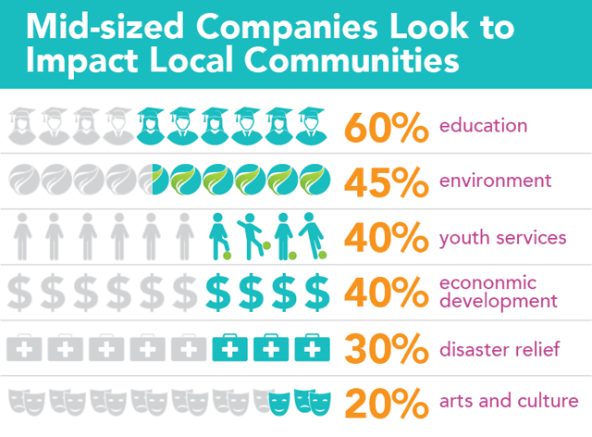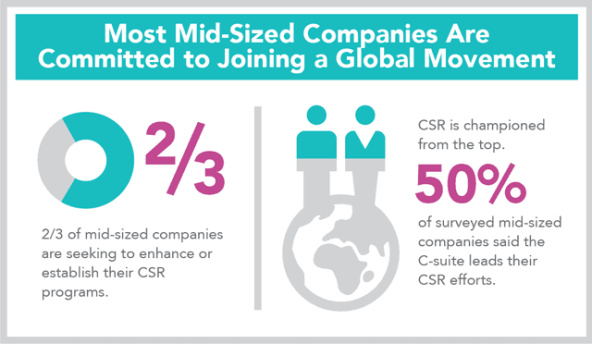Business with a purpose is a mantra moving through boardrooms, corner offices, human resources (HR) teams, and the nonprofit and philanthropic communities. While many large, public companies lead the way in corporate social responsibility (CSR), both the desire and opportunity to do socially good work are abundant for companies of all sizes. I’ve learned this is especially true for growing, mid-sized organizations, which are more often woven into the fabric of the communities in which their employees and customers live.
I am a volunteer and a part of Business4Better, a movement designed to teach any employee or business leader how CSR and business-nonprofit partnerships can lead to greater commercial success for their business. In January 2013, our team launched a research initiative to better understand the gaps and opportunities that mid-sized companies face in their CSR efforts, with the ultimate goal of creating action plans for executives trying to infuse social good as part of the way they do business. More than 170 executives from mid-sized organizations (100 to 5,000 employees) were surveyed to explore trends in social innovation, community engagement, and employee volunteering initiatives. The results uncovered some surprises and some irony in the state of community efforts led by this powerful class of businesses, which comprises roughly 26 percent of US businesses, according to The Midmarket Institute. You can read a full summary of the report, but below are some interesting highlights.
• Companies’ community involvement is driven by purpose and not profit. An overwhelming majority—three-quarters of participants—said it is the opportunity to impact communities that underscores the need for CSR programs. Only 12 percent looked to use community engagement to impact the bottom line.
• Companies most commonly support a cause through donations, but there is opportunity to shift this culture of “checkbook philanthropy” to meaningful, company-wide engagement. A significant proportion of mid-sized companies provide the framework for employee engagement beyond donations: Nearly 40 percent of surveyed companies provide time off for employees to volunteer, and more than 30 percent perform pro-bono services. In spite of this, employee participation remains low. Mid-sized organizations such as Jane Cosmetics, technology solutions provider Appirio, and Vitamin Shoppe are some of the companies choosing to shift away from this “checkbook philanthropy.”
Are you enjoying this article? Read more like this, plus SSIR's full archive of content, when you subscribe.
• Companies prefer to focus their social and community engagement efforts on local, people-focused initiatives. Almost two-thirds of mid-sized companies focus their organization’s CSR programs within their main offices’ state. Most work with a small number of nonprofits for community involvement: more than one but fewer than five.
 Mid-sized companies prefer to focus their CSR efforts on local, people-focused initiatives. (Illustration courtesy of Business4Better)
Mid-sized companies prefer to focus their CSR efforts on local, people-focused initiatives. (Illustration courtesy of Business4Better)
• A company’s community involvement is championed from the top. Yet, this does not always trickle down to drive company-wide engagement. Half of surveyed mid-sized companies said executive leadership, such as a CEO or owner, leads CSR efforts. This high-level support is often attributed to personal connections that executive leadership has with a cause. Many mid-sized companies are still managed by their founders that drive the organization’s philanthropic passions. However, overall employee engagement is a weak spot for many mid-sized companies, with most seeing less than 20 percent of their employees participating in these programs.
 The survey results show that most mid-sized companies are committed to joining a global movement of companies that seek to do business with a purpose. (Illustration courtesy of Business4Better)
The survey results show that most mid-sized companies are committed to joining a global movement of companies that seek to do business with a purpose. (Illustration courtesy of Business4Better)
• The metrics of success do not match companies’ goals for CSR. Few companies use CSR as a tool for employee engagement, yet they treat participation as an indicator of program success. Less than 10 percent of companies surveyed said they use CSR for employee engagement. More than 40 percent said they measure their community involvement programs by employee participation or employee satisfaction. Most surprisingly, more than one third of companies surveyed do not measure their programs at all. Clearly, there is a significant gap in the ways companies map out and measure their CSR efforts. With the right resources, training, and approach, companies can track and evaluate their CSR efforts from start to finish.
As I analyzed the survey results, it was clear to me that companies are missing opportunities to tie community and social innovation programs to successful business performance. While larger corporations may look to community involvement as a way to increase profits, most mid-sized companies do not. In fact, only about 20 percent of mid-sized companies measure a CSR program’s success by its financial impact. If goals and measurement indicators are set up properly from the start, bottom line, employee satisfaction, staff loyalty, brand image, and the ability to attract new talent can be success indicators of a company’s community involvement and CSR program.
Learn more about the movement here or participate in the Business4Better conference on May 1 and 2, 2013, in Anaheim, Calif.
Support SSIR’s coverage of cross-sector solutions to global challenges.
Help us further the reach of innovative ideas. Donate today.
Read more stories by Scott Vaughan.

